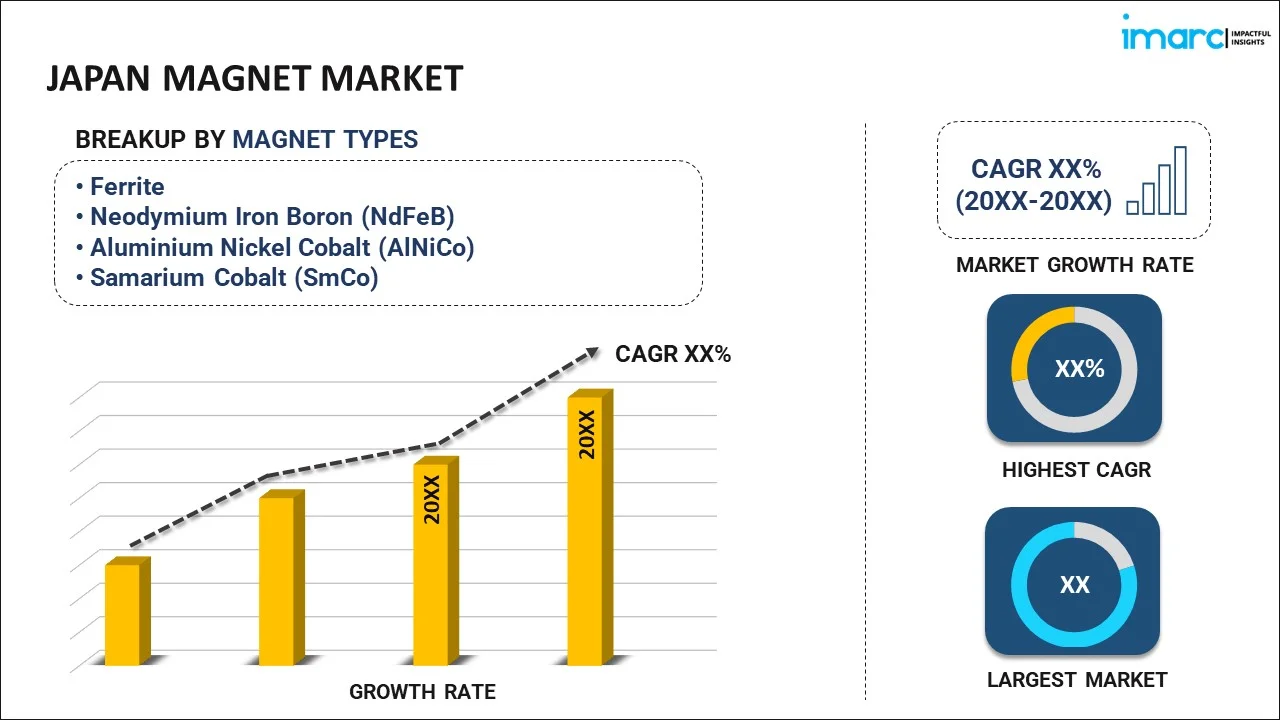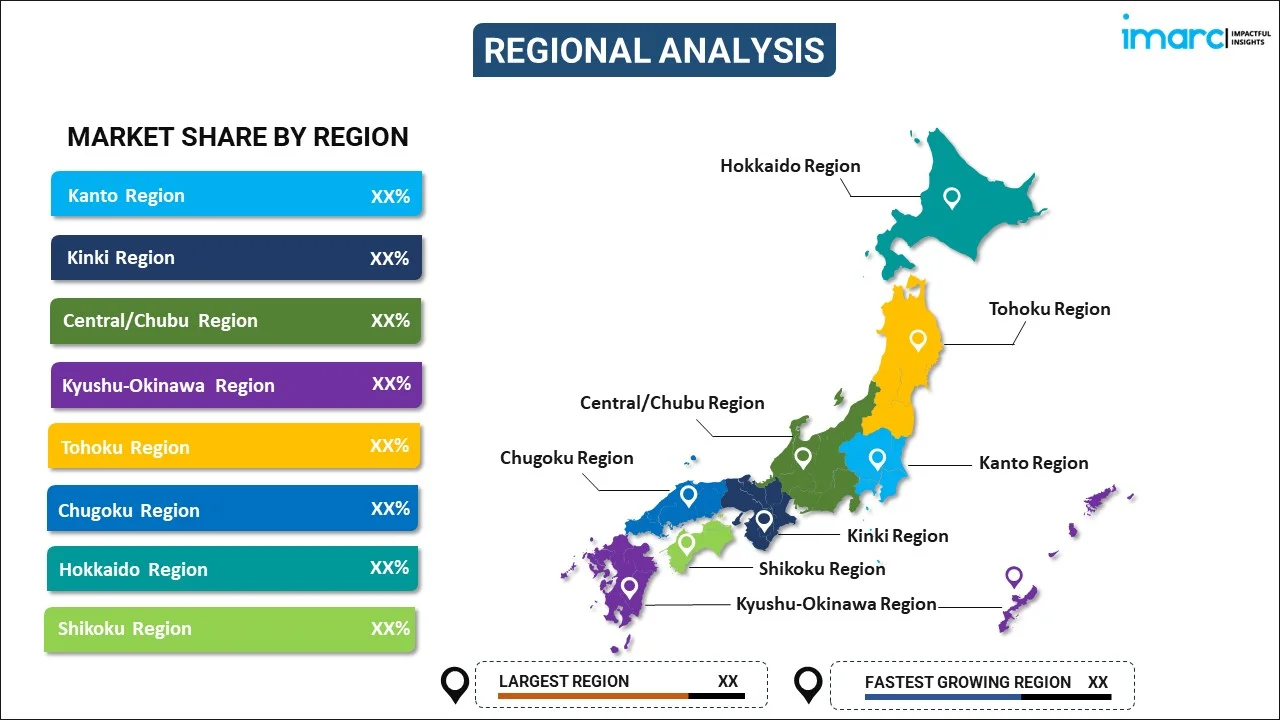
Japan Magnet Market Report by Magnet Type (Ferrite, Neodymium Iron Boron (NdFeB), Aluminium Nickel Cobalt (AlNiCo), Samarium Cobalt (SmCo)), Application (Computer Hard Disk Drives (HDD), CD, DVD, Hybrid Electric Vehicles, Electric Bicycles, Heating, Ventilating and Air Conditioners (HVAC), Wind Turbines, and Others), and Region 2025-2033
Market Overview:
The Japan magnet market size reached USD 2.5 Billion in 2024. Looking forward, IMARC Group expects the market to reach USD 3.3 Billion by 2033, exhibiting a growth rate (CAGR) of 3.3% during 2025-2033. Ongoing technological innovation, the bolstering growth of the electronics and automotive industries, the growing demand for renewable energy solutions, and the increasing applications in the healthcare sector represent some of the key factors driving the market.
|
Report Attribute
|
Key Statistics
|
|---|---|
|
Base Year
|
2024 |
|
Forecast Years
|
2025-2033
|
|
Historical Years
|
2019-2024
|
| Market Size in 2024 | USD 2.5 Billion |
| Market Forecast in 2033 | USD 3.3 Billion |
| Market Growth Rate (2025-2033) | 3.3% |
A magnet is a material or object that pulls on other ferromagnetic materials and attracts or repels other magnets. This remarkable property is known as magnetism, which manifests through an invisible magnetic field extending into the surrounding space. The most common type of magnet is the bar magnet, typically composed of iron or steel, featuring two distinct poles, a north pole and a south pole. Magnetism exerts a force on magnetic materials, causing them to align along the magnetic field lines when near a magnet. Opposite poles attract each other, while similar poles repel, resulting in a wide array of practical applications. Consequently, they are available in different shapes and sizes, depending on the usage, such as refrigerator, electric motors, generators, and magnetic resonance imaging (MRI) machines utilized in medical diagnostics. Magnets can be naturally found on the Earth or created artificially, and their properties stem from the motion of electric charges within the material.
Japan Magnet Market Trends:
The market is primarily driven by the country's strong focus on technological advancements and innovation. Japan has established itself as one of the global leaders in manufacturing and engineering, consistently pushing the boundaries of research and development. This drive for innovation has led to the increasing demand for magnets in diverse applications, including electronics, automotive, renewable energy, and healthcare. Moreover, the rising utilization of permanent magnets, such as neodymium-iron-boron (NdFeB) magnets, in smartphones, laptops, hard disk drives, and various consumer electronics is contributing to the market’s growth. Besides this, with continuous miniaturization and enhancement of electronic gadgets, there is a surging demand for smaller yet more powerful magnets, which, in turn, is creating a favorable outlook for market expansion. In addition to this, the bolstering growth of the automotive industry is strengthening the market growth as modern automobiles rely heavily on electric motors and various sensors equipped with magnets. Concurrently, the increasing adoption of electric and hybrid vehicles (E/HVs) has further enhanced the demand for magnets, particularly rare-earth magnets such as neodymium magnets and samarium-cobalt magnets, due to their high magnetic strength and efficiency, which is aiding in market expansion. Furthermore, the expanding renewable energy infrastructure of the country and the push towards sustainable energy sources, increasing the deployment of wind turbines and solar power systems that require magnets, are influencing the market growth. Besides this, the growing product utilization in the healthcare sector, particularly in medical diagnostics technologies, is acting as another significant growth inducing factor.
Japan Magnet Market Segmentation:
IMARC Group provides an analysis of the key trends in each segment of the Japan magnet market report, along with forecasts at the country level for 2025-2033. Our report has categorized the market based on magnet type and application.
Magnet Type Insights:

- Ferrite
- Neodymium Iron Boron (NdFeB)
- Aluminium Nickel Cobalt (AlNiCo)
- Samarium Cobalt (SmCo)
The report has provided a detailed breakup and analysis of the market based on the magnet type. This includes ferrite, neodymium iron boron (NdFeB), aluminium nickel cobalt (AlNiCo), and samarium cobalt (SmCo).
Application Insights:
- Computer Hard Disk Drives (HDD), CD, DVD
- Hybrid Electric Vehicles
- Electric Bicycles
- Heating, Ventilating and Air Conditioners (HVAC)
- Wind Turbines
- Others
A detailed breakup and analysis of the market based on the application has also been provided in the report. This includes computer hard disk drives (HDD), CD, DVD, hybrid electric vehicles, electric bicycles, heating, ventilating and air conditioners (HVAC), wind turbines, and others.
Regional Insights:

- Kanto Region
- Kinki Region
- Central/ Chubu Region
- Kyushu-Okinawa Region
- Tohoku Region
- Chugoku Region
- Hokkaido Region
- Shikoku Region
The report has also provided a comprehensive analysis of all the major regional markets, which include Kanto Region, Kinki Region, Central/ Chubu Region, Kyushu-Okinawa Region, Tohoku Region, Chugoku Region, Hokkaido Region, and Shikoku Region.
Competitive Landscape:
The report has also provided a comprehensive analysis of the competitive landscape in the market. Competitive analysis such as market structure, key player positioning, top winning strategies, competitive dashboard, and company evaluation quadrant has been covered in the report. Also, detailed profiles of all major companies have been provided.
Japan Magnet Market Report Coverage:
| Report Features | Details |
|---|---|
| Base Year of the Analysis | 2024 |
| Historical Period | 2019-2024 |
| Forecast Period | 2025-2033 |
| Units | Billion USD |
| Scope of the Report | Exploration of Historical and Forecast Trends, Industry Catalysts and Challenges, Segment-Wise Historical and Predictive Market Assessment:
|
| Magnet Types Covered | Ferrite, Neodymium Iron Boron (NdFeB), Aluminium Nickel Cobalt (AlNiCo), Samarium Cobalt (SmCo) |
| Applications Covered | Computer Hard Disk Drives (HDD), CD, DVD, Hybrid Electric Vehicles, Electric Bicycles, Heating, Ventilating and Air Conditioners (HVAC), Wind Turbines, Others |
| Regions Covered | Kanto Region, Kinki Region, Central/ Chubu Region, Kyushu-Okinawa Region, Tohoku Region, Chugoku Region, Hokkaido Region, Shikoku Region |
| Customization Scope | 10% Free Customization |
| Post-Sale Analyst Support | 10-12 Weeks |
| Delivery Format | PDF and Excel through Email (We can also provide the editable version of the report in PPT/Word format on special request) |
Key Questions Answered in This Report:
- How has the Japan magnet market performed so far and how will it perform in the coming years?
- What has been the impact of COVID-19 on the Japan magnet market?
- What is the breakup of the Japan magnet market on the basis of magnet type?
- What is the breakup of the Japan magnet market on the basis of application?
- What are the various stages in the value chain of the Japan magnet market?
- What are the key driving factors and challenges in the Japan magnet market?
- What is the structure of the Japan magnet market and who are the key players?
- What is the degree of competition in the Japan magnet market?
Key Benefits for Stakeholders:
- IMARC’s report offers a comprehensive quantitative analysis of various market segments, historical and current market trends, market forecasts, and dynamics of the Japan magnet market from 2019-2033.
- The research study provides the latest information on the market drivers, challenges, and opportunities in the Japan magnet market.
- Porter's five forces analysis assist stakeholders in assessing the impact of new entrants, competitive rivalry, supplier power, buyer power, and the threat of substitution. It helps stakeholders to analyze the level of competition within the Japan magnet industry and its attractiveness.
- Competitive landscape allows stakeholders to understand their competitive environment and provides an insight into the current positions of key players in the market.
Need more help?
- Speak to our experienced analysts for insights on the current market scenarios.
- Include additional segments and countries to customize the report as per your requirement.
- Gain an unparalleled competitive advantage in your domain by understanding how to utilize the report and positively impacting your operations and revenue.
- For further assistance, please connect with our analysts.
 Inquire Before Buying
Inquire Before Buying
 Speak to an Analyst
Speak to an Analyst
 Request Brochure
Request Brochure
 Request Customization
Request Customization




.webp)




.webp)












